|
|
|
Subspecies of the Horned Lark
by Ron Pittaway |
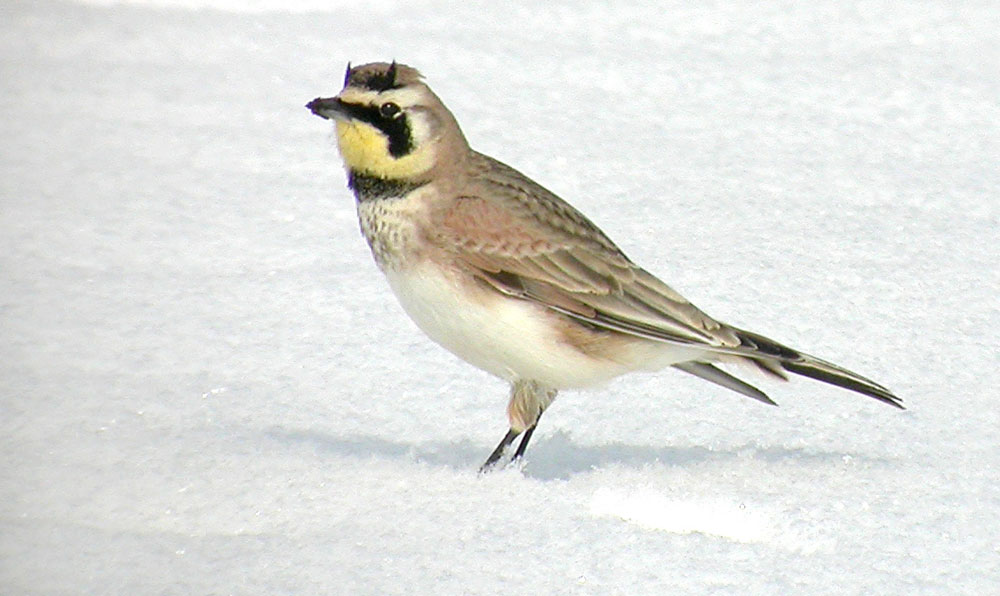 |
|
Prairie Horned Lark at
Keswick, Ontario, showing the erect "horns". 21 March 2005. |
|
|
|
Revised January 2014.
First published in Ontario Birds 12 (3): 109-115. December 1994 |
|
|
|
Introduction |
|
The very first recognizable forms I learned as a young birder were
the Prairie Horned Lark (Eremophila alpestris
praticola)
and the Northern Horned Lark (E.
a.
alpestris).
These two subspecies were often mentioned by John Bird in his Saturday
column in the Ottawa Journal.
As an example, he reported on 6 February 1965, "Earl Godfrey found
three Northern Horned Larks near Fallowfield. He had a close enough
look to identify them as Northerns. Prairie Horned Larks would have
been more suggestive of migration."
In what follows, I discuss the differences in coloration, size,
behaviour, song, migration, habitat, breeding times and ranges which
taken together distinguish the three recognizable forms of the
Horned Lark in Ontario. |
|
|
|
Taxonomy |
|
The American Ornithologists' Union (AOU) (1957) and Godfrey (1986)
list four subspecies of the Horned Lark in Ontario: nominate
E.
a.
alpestris,
E.
a.
praticola, E.
a.
hoyti
and E.
a. enthymia.
The listing of
enthymia
in Ontario by the above authorities is based on Snyder (1938) who
collected specimens in western Rainy River District for the Royal
Ontario Museum. However, James (1991) who re-evaluated Snyder's work
does not list
enthymia
in Ontario because the Rainy River birds are "more like
praticola
than enthymia". Peters (1960) treats enthymia as
"doubtfully distinct" from the more western leucolaema.
Affinities of enthymia and leucolaema require study
(Godfrey1986). Below, I discuss
enthymia
in more detail under the Saskatchewan Horned Lark. |
|
|
|
Plumages, Molts,
Ageing
and Sexing |
|
Horned Larks have only two plumages: juvenile (juvenal) and adult
(definitive basic). The briefly held spotted juvenile plumage is
quite unlike the adult and has tempted some birders to believe they
have found a rare pipit or longspur. See the illustration of a juvenile on page 367 in the National Geographic Guide
(Dunn and Alderfer 2011) and the photograph on page 297 in Volume 2 of the
Master Guide (Farrand 1983).
Horned Larks acquire their first adult plumage by late summer of
their hatching year (Earl Godfrey, pers. comm.}, Unlike most birds,
the post-juvenile (preformative) molt is complete (all feathers).
First year adults are on average duller and with more spots than older adults;
extremes may be separable with experience (Pyle 1997).
|
|
|
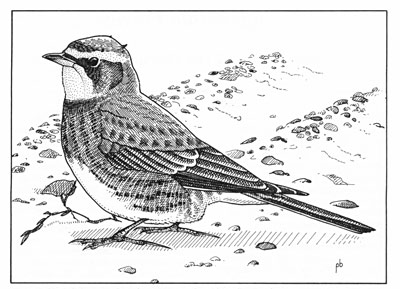 |
|
On males, the black
collar, mask, crown and "horns" (erectile feathers) are more
distinct than on females. Males are also larger than females. Adults
have one complete molt a year after breeding but before fall
migration. On fresh fall and slightly worn winter birds, the black
markings on the head (including "horns") and breast are obscured by
pale feather fringes and the birds are more pinkish, buffy and
streaked (Figure 1). There is no prebreeding (prealternate) molt.
The breeding dress is acquired by the gradual wearing away of the
feather edgings, bringing the black markings into prominence. During
the breeding season, the normally inconspicuous "horns" are often
erected in display. Note that birds depicted in field guides are in
worn, not fresh, plumage.
In summary, Horned
Larks have the same plumage year round but the appearance of fresh
fall birds is markedly different from worn spring and summer birds.
See Ridgway (1907), Bent (1942) and Roberts (1955) for detailed
plumage descriptions of each subspecies. |
|
|
Figure 1. Adult male
Northern Horned Lark in fresh plumage. Drawing by Peter Burke. |
|
|
|
Prairie Horned Lark (E. a. praticola) |
|
The Prairie Horned
Lark breeds commonly in southern Ontario south of the Canadian
Shield, locally and sparsely in farming areas north to the Clay
Belt, as well as in western Rainy River District (James 1991). The
breeding range of the Prairie subspecies is separated from the
breeding ranges of the two northern subspecies by a wide band of
boreal forest. |
|
|
|
Small numbers of Prairie Horned Larks winter southern Ontario, but are normally outnumbered by the Northern
subspecies (Dennis Rupert, pers. comm.). Prairie Horned Larks are
very early spring migrants (earliest land bird) arriving in numbers
north of Lake Erie by early February and north of Lake Ontario by
mid-February. Prairie birds are usually paired, and males are
singing on territories when the first flocks of Northern Horned
Larks move through southern Ontario (Devitt 1967, Sadler 1983). The
top of Figure 4 shows a typical early March scene near Toronto with
a "skylarking" male Prairie Horned Lark singing over its breeding
territory.
Separation of Prairie and Northern Horned Larks is usually
straightforward. The superciliary
(eyebrow) stripe is white in the Prairie (sometimes very pale yellow
in front of the eye) (Figure 2) whereas the superciliary
stripe is usually bright yellow in the
Northern (Figure 3). A typical Prairie Horned Lark in worn plumage is
illustrated on Plate 55 in The
Birds of Canada
(Godfrey 1986). Peterson (2008) illustrates both Prairie and
Northern subspecies on page 296. A Horned Lark singing in southern
Ontario is the Prairie subspecies. |
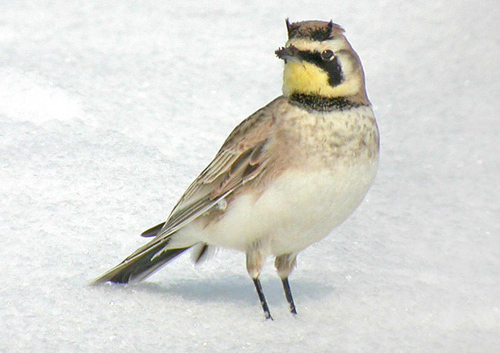 |
|
|
|
|
Note that the Hoyt's Horned Lark is larger but very similar in
appearance to the Prairie subspecies; see discussion under account
of Hoyt's Horned Lark below. |
Figure 2. Prairie Horned Lark at
Keswick, Ontario, 22 March 2005 |
|
|
|
Northern Horned Lark: (E.
a. alpestris) |
|
The nominate subspecies is the northeastern form. It breeds from
"northern Quebec and northern Labrador south to southern James Bay,
southeastern Quebec (Gaspe Peninsula, Madeleine Islands), and
Newfoundland" (Godfrey 1986). It intergrades with E.
a. hoyti
in northern Ontario (James 1991). See the discussion below under the
heading "Intergrades". |
|
|
|
In southern Ontario, Northern and Prairie Horned Larks have
different migration and behaviour patterns that help to distinguish
them. In spring, Northerns
migrate later than Prairies with
numbers peaking from March to mid-April after most Prairies have
begun nesting.
Northern
Horned Larks do not sing during winter and on spring
migration in southern Ontario.
Farther north in Algonquin Park, Tozer (2011) shows the different
spring migration times of Prairies (28 February to 1 April) and Northerns (13 April to 4 June). |
|
|
|
Peter Burke's illustration at the bottom of Figure 4 shows migrant Northerns in early May at the airfield in Algonquin Park. A few
early Northerns probably reach James Bay in April, but most arrive
there from mid-May to early June (Manning 1952, Manning 1981, Todd
1963).
In autumn, the first Northerns arrive in southern Ontario by
mid-September
and peak through October with numbers falling off in November.
Dates in
Algonquin Park for Northerns range from 6 September to 21 November (Tozer
2011).
Unlike Prairie birds, flocks
of Northerns are often seen along the shorelines of the Great Lakes
in autumn. Small numbers of Northerns winter in southern Ontario,
rarely north to Ottawa, and normally outnumber the Prairie
subspecies in mid-winter (Tozer
and Richards
1974, Weir 1989 and Dennis Rupert, pers. comm.).
Compared with the Prairie subspecies, the Northern is larger and
more robust (noticeable in the field) and the eyebrows, forehead,
cheeks and throat are distinctly yellow (Roberts 1955, Todd 1963). |
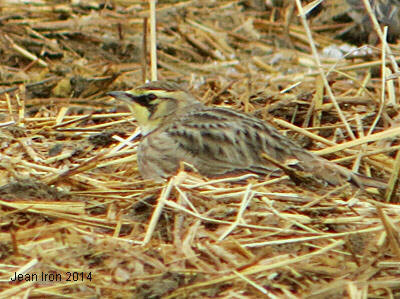 |
|
|
Figure
3. Northern Horned Lark near Oshawa on 14 January 2014 |
|
|
|
|
Hoyt's Horned Lark: (E. a. hoyti) |
|
|
Hoyt's is the northcentral
subspecies.
It breeds on the “arctic islands south to northeastern
Alberta,
northwestern
Saskatchewan,
northeastern
Manitoba,
extreme northwestern
Ontario (Fort Severn)” (Godfrey1986). It intergrades with alpestris
along the coast of Hudson Bay in Ontario (James 1991).Hoyt's
migrates mainly through the Prairie Provinces (Taverner
1937)
and is a regular migrant from Lake Superior westward (Alan
Wormington, pers. comm.).
Hoyt's is a large bird like
alpestris
but similar in appearance to the smaller
praticola,
typically with a white supercilium
and pale
yellow restricted to the middle of the throat (Ridgway 1907, Roberts
1955).
It is a rare to uncommon migrant and winter visitor to southern
Ontario usually mixed in with large flocks of Northerns. For
example, Don Sutherland, Bill Crins
and
Rory MacKay found one Hoyt's among 83 Northern Horned Larks and four
Lapland Longspurs
(Calcarius
lapponicus)
in Algonquin Park on 7 October 1984 (Tozer 2012). Sutherland (in
litt.)
describes the Hoyt's as being “conspicuous amongst the Northerns”
with its “white supercilium, forehead, throat and breast; the latter
two features showing just the faintest hint of yellowish wash”. In
addition, Don Sutherland (in
litt.),
Paul Pratt and Alan Wormington
visited a feeder in Leamington in February 1982, “where a wintering
flock of Horned Larks contained many
praticola
and two hoyti
amongst the predominant alpestris.
There, compared side by side, the hoyti
dwarfed the otherwise similar praticola,
and seemed larger and distinctly paler than alpestris”,
However,
the paler colour may only be obvious when the birds are compared
side by side.
Dates for Hoyt's in southern Ontario, based on specimens in the
Canadian Museum of Nature, range from 22 September to 26 May (Bruce
Di Labio, pers. comm.). |
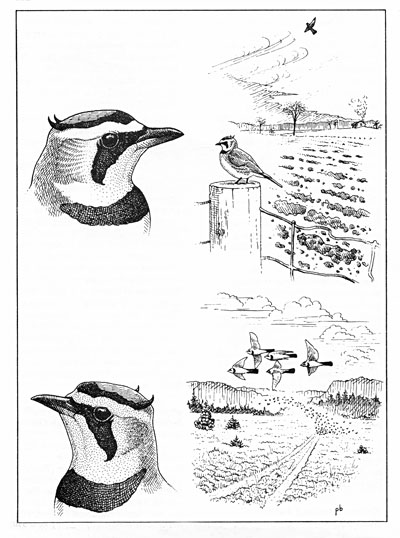 |
|
|
Figure 4. Top: Adult male Prairie Horned
Lark in worn plumage and breeding birds on territory near Toronto in
March. Bottom: Adult male Northern Horned Lark
in worn plumage and May migrants in Algonquin Park. By Peter Burke. |
|
|
|
|
Saskatchewan Horned Lark (E. a. enthymia) |
|
This pale subspecies of the Prairie Provinces is listed by the AOU
(1957) and Godfrey (1986) for extreme western Ontario based on
Snyder (1938). However, James (1991) states, “The birds from western
Rainy River, considered by Snyder (1938) to be enthymia
from the central prairies, are darker than birds from Manitoba, and
scarcely lighter than birds from southern Ontario. The western birds
may be somewhat intermediate, but are more like praticola
than
enthymia,
in my estimation”. Therefore enthymia
is not listed for Ontario (James 1991).
Nevertheless, observers in the Rainy River area should check flocks
of smaller Prairie Horned Larks for similar-sized but very pale
Horned Larks suggestive of
enthymia.
See the illustration (poor quality) on page 367 in the National
Geographic Guide (Dunn and Alderfer 2011). |
|
|
|
Intergrades |
|
Subspecies are not species and by definition interbreed freely where
their ranges meet. Intergrades are birds showing characteristics
intermediate between two subspecies (Earl Godfrey, pers. comm.).
Most breeding birds along the Ontario coast of Hudson Bay are
intergrades between alpestris and
hoyti.
James (1991) states, “Birds from northern Ontario may be similar to
either hoyti,
paler yellowish about the head with a less vinaceous colour, or to
alpestris,
with strong yellows and darker backs. Most, however, are
intermediate with rather paler yellows and more vinaceous
backs.” Therefore one may encounter intergrades in southern Ontario,
but most migrants should be either pure alpestris
or pure hoyti because the large populations of each
subspecies greatly outnumber the much smaller population of
intergrades. This is borne out by specimens in the Canadian Museum
of Nature (Michel Gosselin, pers. comm.). |
|
|
|
Summary |
|
|
The identification of Prairie and
Northern Horned Larks is usually straightforward in southern Ontario
where most larks are either one or the other. Hoyt's Horned Lark is
a rare to uncommon migrant and winter visitor to southern Ontario,
normally found associating with flocks of Northerns. Hoyt's is a
large subspecies like the Northern, but very similar in appearance
to the smaller Prairie, and should be identified with caution. The
identification of subspecies should be based on a number of
characteristics taken together. Be aware of intergrades, and
remember, you just cannot identify all birds to subspecies. |
|
|
|
|
|
Acknowledgements |
|
I thank David Agro
(Academy of Natural Sciences of Philadelphia), Peter Burke, Bill
Crins, Bruce Di Labio, Earl Godfrey, Michel Gosselin (Canadian
Museum of Nature), Jean Iron, Ross James (Royal Ontario Museum),
Dennis Rupert, Don Sutherland, Ron Tozer, Mike Turner and Alan
Wormington for much valuable advice and assistance. A study such as
this is only possible because of the information gained from the
staff and collections at the Canadian Museum of Nature, the Royal
Ontario Museum and the Academy of Natural Sciences of Philadelphia.
Once again, I am indebted to Peter Burke for his marvellous
illustrations and strong support for the concept of recognizable
forms. |
|
|
|
Literature Cited |
|
American Ornithologists' Union. 1957.Check-list
of North American Birds, 5th Edition. American Ornithologists'
Union, Washington, D.C.
Bent, A.
C. 1942. Life Histories of North American Flycatchers, Larks,
Swallows, and Their Allies. United States National Museum Bulletin
179. Washington, D.C.
Devitt, O.E.
1967. The Birds of Simcoe County. The Brereton Field Naturalists'
Club, Barrie, Ontario.
Dunn, J.L. and J. Alderfer 2011.
Field Guide to the Birds of North America. National Geographic
Society, Washington, D.C.
Farrand, J.F. Jr. (Editor).
1983. The Audubon Society Master Guide to Birding. Volume 2. Alfred
Knopf, New York.
Godfrey, W.E.
1986. The Birds of Canada. Revised Edition. National Museum of
Canada. Ottawa.
James, R.D.
1991. Annotated Checklist of the Birds of Ontario. Second Edition.
Life Sciences Miscellaneous Publications, Royal Ontario Museum,
Toronto.
Manning, T.R.
1952. Birds of the West James Bay and Southern Hudson Bay Coast.
Bulletin No. 125, National Museum of Canada.
Manning,
T.R.
1981. Birds of the Twin Islands, James Bay, N.W.T., Canada. Syllogeus
No.
30, National Museums of Canada.
Peters, J.L.
1960. Checklist of the Birds of the World. Volume 9. Harvard
University Press, Cambridge, Massachusetts.
Peterson, R.T.
2008. Field Guide to the Birds of North America. Houghton Mifflin
Company, Boston.
Pyle, P.
1997. Identification Guide to North American Birds Part 1. Slate
Creek Press, Bolinas, California.
Ridgway,
R 1907. The Birds of North and Middle America. Bulletin of the
United States National Museum, No. 50. Smithsonian Institution,
Washington, D.C.
Roberts, T.S.
1955. The Birds of Minnesota. University of Minnesota Press,
Minneapolis.
Sadler,
D. 1983. Our Heritage of Birds, Peterborough County in the Kawarthas.
Orchid Press, Peterborough, Ontario.
Snyder, L.L.
1938. A faunal investigation of western Rainy River District,
Ontario. Transactions of the Royal Canadian Institute 47: 157-213.
Taverner, P.A.
1937. Birds of Canada. The National Museum of Canada. Ottawa.
Todd, W.E.C.
1963. Birds of the Labrador Peninsula and Adjacent Areas. Carnegie
Museum and University of Toronto Press.
Tozer, R. 2011. Checklist and Seasonal Status of the Birds of
Algonquin Provincial Park. Algonquin Park Technical Bulletin No. 9.
The Friends of Algonquin Park, Whitney, Ontario.
Tozer, R. 2012. Birds of Algonquin Park. The Friends of
Algonquin Park, Whitney, Ontario.
Tozer, R.G., and J.M. Richards. 1974.
Birds of Oshawa- Lake 5cugog Region, Ontario. Published by the
Authors.
Weir, R.D.
1989. Birds of the Kingston Region. Quarry Press, Kingston, Ontario. |
|
|
|
|
|
|
|